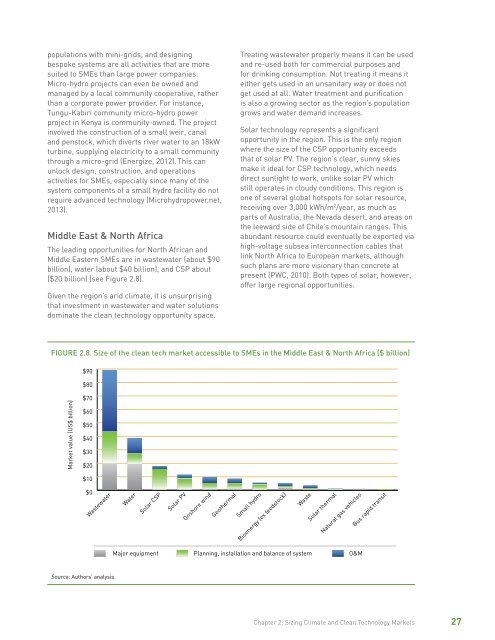Building Competitive Green Industries
green-industries
green-industries
You also want an ePaper? Increase the reach of your titles
YUMPU automatically turns print PDFs into web optimized ePapers that Google loves.
populations with mini-grids, and designingbespoke systems are all activities that are moresuited to SMEs than large power companies.Micro-hydro projects can even be owned andmanaged by a local community cooperative, ratherthan a corporate power provider. For instance,Tungu-Kabiri community micro-hydro powerproject in Kenya is community-owned. The projectinvolved the construction of a small weir, canaland penstock, which diverts river water to an 18kWturbine, supplying electricity to a small communitythrough a micro-grid (Energize, 2012). This canunlock design, construction, and operationsactivities for SMEs, especially since many of thesystem components of a small hydro facility do notrequire advanced technology (Microhydropower.net,2013).Middle East & North AfricaThe leading opportunities for North African andMiddle Eastern SMEs are in wastewater (about $90billion), water (about $40 billion), and CSP about($20 billion) (see Figure 2.8).Given the region’s arid climate, it is unsurprisingthat investment in wastewater and water solutionsdominate the clean technology opportunity space.Treating wastewater properly means it can be usedand re-used both for commercial purposes andfor drinking consumption. Not treating it means iteither gets used in an unsanitary way or does notget used at all. Water treatment and purificationis also a growing sector as the region’s populationgrows and water demand increases.Solar technology represents a significantopportunity in the region. This is the only regionwhere the size of the CSP opportunity exceedsthat of solar PV. The region’s clear, sunny skiesmake it ideal for CSP technology, which needsdirect sunlight to work, unlike solar PV whichstill operates in cloudy conditions. This region isone of several global hotspots for solar resource,receiving over 3,000 kWh/m 2 /year, as much asparts of Australia, the Nevada desert, and areas onthe leeward side of Chile’s mountain ranges. Thisabundant resource could eventually be exported viahigh-voltage subsea interconnection cables thatlink North Africa to European markets, althoughsuch plans are more visionary than concrete atpresent (PWC, 2010). Both types of solar, however,offer large regional opportunities.FIGURE 2.8. Size of the clean tech market accessible to SMEs in the Middle East & North Africa ($ billion)$90$80Market value (US$ billion)$70$60$50$40$30$20$10$0WastewaterWaterSolar CSPSolar PVOnshore windGeothermalSmall hydroBioenergy (ex feedstock)WasteSolar thermalNatural gas vehiclesBus rapid transitMajor equipment Planning, installation and balance of system O&MSource: Authors’ analysis.Chapter 2: Sizing Climate and Clean Technology Markets27


